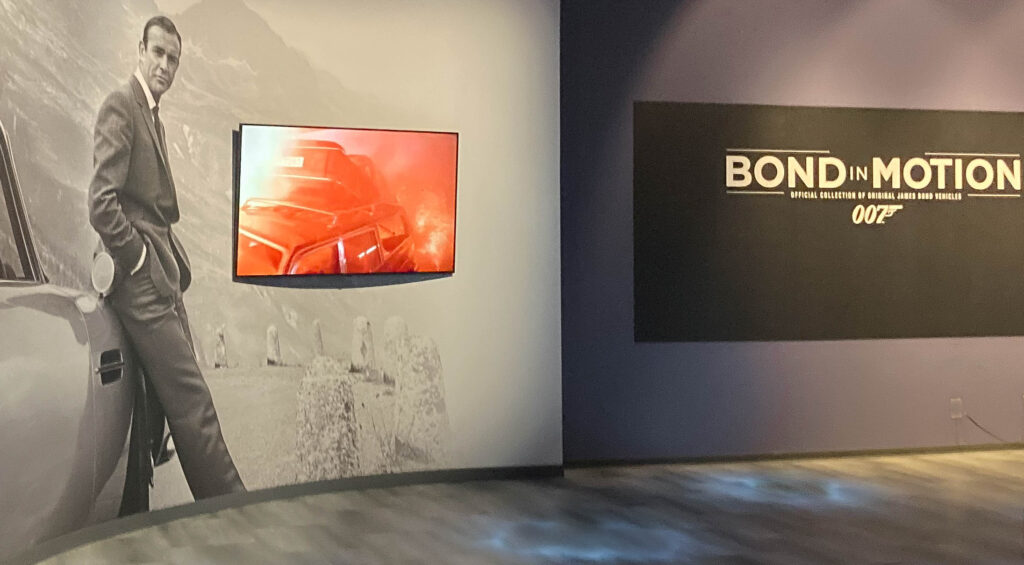Sometimes, the things you’re the least interested in can turn out to be among the most intriguing.
This post contains affiliate links. For more information, click here.
The International Spy Museum in Washington, D.C., recently opened “Bond in Motion“, a special exhibition of 17 vehicles featured in James Bond films. There are also props and scale models, and movie clips play alongside their featured vehicles.
I am not a car person. I rarely drive, unless I’m on a road trip, and my own car is a 13-year-old sedan. I’m also not a James Bond person; my espionage interests are historic, not futuristic. But as a member, or “Operative”, of the International Spy Museum, I had the opportunity to see the exhibit a couple of days before the crowds. So I Ubered into Washington, and it was worth it.
It was a rare chance to see classic cars up close, like the Aston Martin Vanquish from Die Another Day.
Other vehicles include the one-person submarine from Diamonds are Forever, the Hydrofoil boat from Moonraker, and the Flying Parahawk from The World Is Not Enough.
But the real fun for me was the interactive games. This is where the International Spy Museum stands out. We learn best by applying information in ways that make us think. The Museum is filled with thinking games, and “Bond in Motion” is no exception.
There are two games with different variations. The first one I played gives you the chance to recreate stunts from Bond movies. For example, in Casino Royale, there’s a scene where Bond is speeding his Aston Martin DBS down a wet and winding road in Montenegro. Suddenly he sees double-agent Vesper Lynd (who’d been kidnapped by terrorist-banker Le Chiffre) tied up and lying helplessly in the road. Naturally, Bond swerves the car into a seven-rotation barrel roll and lands upright in the surrounding woods.
The game gives players the chance to make decisions about how to execute this stunt the way that the film’s special-effects team did. Don’t worry: The game gives you the information you need; you just have to put it together and make a few simple choices. After you play, the exhibit gives you the backstory of how the special-effects crew did it. Those laughable stunts actually do have some tethering to the laws of physics!
In the next game I played, you get to outfit an Aston Martin DB5 with the options that will help Bond evade death under different conditions. It tells you the different things to consider, like the climate and terrain and the gadgets used by Bond’s adversaries, and then you pick three options that will best enhance the car’s advantages for Agent 007. Your design goes though “testing” and the display evaluates your specific choices. I won’t show you my specific results, because that would spoil the answers. But as you can see, I “have a bright future at Q Branch!”
By this point, I was wondering whether they just encourage everybody like that. After all, who wants to go to a museum that tells you, “Please, for the sake of national security, do not go into espionage”?? So I decided to play again making obviously foolish choices, like a champagne refrigerator for the Arctic Circle. The game’s response was like that of a good boss — as positive as possible: “Gadgets need to save lives, not amuse Mr. Bond! Luckily for you, Bond is a highly trained secret agent who can also rely on his resourcefulness and physical abilities to succeed.”
On the other hand, maybe I just don’t learn well after all. I had way too much fun tapping the glass of the shark tank from The Spy Who Loved Me — to the inevitable result every time.
The exhibition runs until April 2025. Tickets may be purchased separately or as an add-on with admission to the International Spy Museum.
Continue your adventure in Washington, D.C.
After my misspent youth as a wage worker, I’m having so much more fun as a blogger, helping other discerning travellers plan fun and fascinating journeys. Read more …

